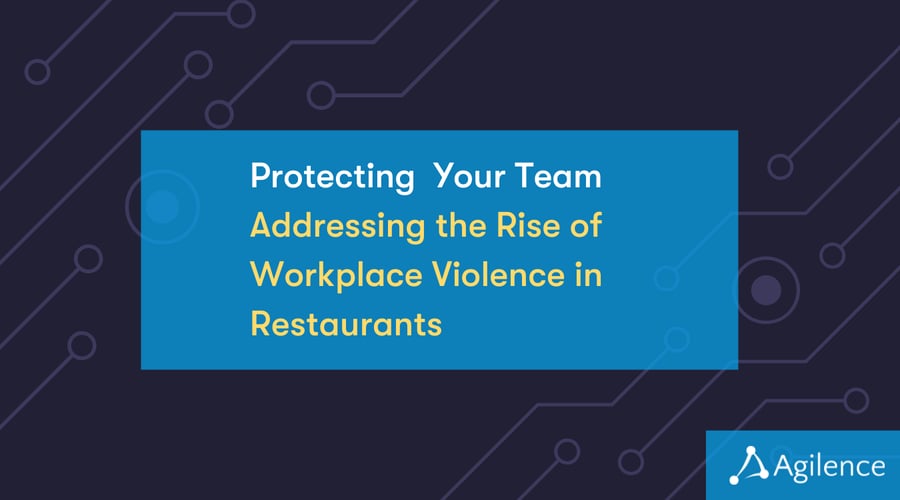Protecting Your Team: Addressing the Rise of Workplace Violence in Restaurants
Restaurant
The rise in workplace violence has become a major concern for restaurant owners and operators. A survey conducted by the National Institute for Occupational Safety and Health (NIOSH) found that 64% of restaurant workers are subjected to some form of workplace violence during their career. And the severity of incidents has grown in recent years, with on-the-job restaurant deaths rising by 22% in 2022.
Workplace violence is an issue that often impacts restaurant owners, operators, and employees deeply. While incidents in any one location may be rare, when such incidents do occur, they can severely harm the employees, customers, and operations of that store. Beyond the immediate physical and emotional harm to employees, such incidents can cause severe legal, financial, and reputational damage for the establishment.
In this blog post, we examine the multifaceted challenge of workplace violence within food service establishments. We will explore the rise in such incidents, the various types of violence that can occur, and the unique considerations that restaurants must keep in mind. Finally, we will discuss actionable strategies and solutions that can be implemented to ensure a safer, more secure environment for employees and customers alike.
The Rise in Workplace Violence in Restaurants
While we don’t have data on the amount of workplace violence incidents since 2020 (the most recently published BLS data found that in 2020, there were 392 homicides and more than 37,000 injuries in the workplace that resulted from intentional violence), many retail and restaurant loss prevention and security professionals have expressed alarm at what they see as a rise in violent incident within the stores they oversee. The aftermath of the COVID pandemic and nationwide George Floyd protests in 2020 led to a sharp rise in violent crime throughout the United States, and restaurants have been among the businesses affected by this trend.
Even before 2020, workplace violence had been rising in the US since 2014. A 2022 federal study found an annual average of 1.3 million nonfatal workplace violence incidents between 2015 and 2019 and an 11% increase in workplace homicides over that period. Restaurant owners and operators, operations professionals, and LP and security personnel are correct to be worried about the potential of violence and take action to mitigate its impact.
The Impact of Workplace Violence on Restaurants
Protecting employees, customers, and communities is so important that it’s in a league of its own when it comes to priorities for any restaurant operator. Financial concerns can’t be compared to the risk of bodily and emotional harm that individuals can suffer in the wake of a violent workplace incident. Preventing these incidents is a special priority at a human level. The safety and well-being of employees and customers transcends business operations and often viscerally impacts owner-operators and managers personally.
Workplace violence can result in serious physical injuries to employees, ranging from minor bruises to life-threatening conditions. The high-risk nature of restaurant work environments—characterized by sharp objects, heavy equipment, and hot surfaces—can exacerbate the severity of these injuries. The psychological impact of workplace violence is equally concerning, and employees who experience or witness violent incidents may suffer from anxiety, depression, or PTSD.
In addition to the human impact, workplace violence can have negative impacts on the financial health and operational stability of restaurants. These include:
- Increased Turnover: High turnover rates are already a challenge in the restaurant industry, and incidents of workplace violence exacerbate this issue. Employees who feel unsafe are more likely to leave their jobs, leading to increased recruitment and training costs. Restaurants with high rates of violence can struggle to retain experienced staff, which affects service quality and overall customer satisfaction.
- Productivity Losses Violent incidents can lead to immediate productivity losses as affected employees may need time off to recover. Additionally, the overall morale and efficiency of the team can suffer. Ensuring a safe work environment helps maintain productivity and minimizes disruptions.
- Higher Insurance Costs: As the risk of workplace violence rises, so do insurance premiums. Insurance companies may charge higher rates to cover businesses in high-risk categories, placing additional financial strain on restaurant operators. In severe cases, repeated incidents of violence can lead to difficulties in obtaining coverage altogether.
- Legal and Regulatory Implications: Restaurants must navigate a complex landscape of legal and regulatory requirements related to workplace safety. Failure to adequately address workplace violence can result in fines and citations from regulatory bodies like OSHA. Additionally, employers may face lawsuits from employees who suffer injuries or trauma due to workplace violence, leading to costly legal battles and settlements.
- Negative Publicity and Loss of Customer Trust. Incidents of workplace violence can attract negative media attention, damaging the restaurant's reputation. Customers may feel unsafe dining at establishments known for violent incidents. Workplace violence can erode their trust and loyalty, leading to a decline in repeat business. Maintaining a secure environment reassures customers and encourages them to return.
Types of Incidents in Food Service Establishments
The National Institute for Occupational Safety and Health categorizes all types of workplace violence into four categories: criminal intent, customer/client, worker-on-worker and personal relationship. Criminal intent involves perpetrators with no relation to the business or employees, usually committing a crime such as robbery; customer/client typically involves an act of violence towards an employee by a customer; worker-on-worker involves intra-employee conflict, while personal relationship involves employee relationships from outside the workplace spilling into the workplace, which overwhelmingly involves domestic violence targeting women.
In a food service setting, we can distill these into three main categories based on the originating party: customers, employees, or external threats. The types of incidents can range from verbal and emotional abuse to unarmed physical confrontations to armed confrontations and active shooter incidents.
Customer-Related Incidents
Physical Altercations. One common type of workplace violence in restaurants involves physical altercations with customers. Quick-Service Restaurants (QSRs) and fast-casual establishments are particularly susceptible due to the high volume of transactions and faster pace. Physical confrontations not only endanger staff but also create a hostile environment for other patrons.
Verbal Abuse and Threats. Verbal abuse remains a significant issue for restaurant employees. Customers may express frustrations through yelling, name-calling, or issuing threats, especially during busy hours or when they perceive service delays. This type of behavior can significantly impact the mental health and job satisfaction of restaurant staff. Verbal threats can sometimes escalate into more serious incidents, making it essential to address them promptly.
Employee-Related Incidents
Conflicts Between Staff Members. Interpersonal conflicts among staff members are common in a restaurant's high-stress environment. Differences in personality, work styles, and communication can lead to arguments and, in some cases, physical fights. Such conflicts disrupt operations and create an uncomfortable workplace atmosphere.
Harassment and Bullying. Harassment and bullying within the workforce can take many forms, from inappropriate comments to physical intimidation. These behaviors can stem from power dynamics, personal prejudices, or stress.
Domestic Violence Spilling into the Workplace. Domestic violence can critically impact the workplace, and restaurants are no exception. An employee experiencing domestic violence may be targeted at their place of work, putting themselves and their colleagues at risk.
External Threats
Vandalism and Property Damage. Acts of vandalism and property damage can also affect restaurants, including chain locations and independent eateries. These incidents may include graffiti, broken windows, or deliberate destruction of property. While such acts of vandalism may not directly harm employees, they contribute to a sense of insecurity and can result in financial losses.
Armed Robberies. Armed robberies are among the most severe external threats faced by restaurants, particularly those operating late at night or in high-crime areas. One example is a recent spate of armed robberies of Waffle House (known for late-night hours) locations in the metro Atlanta area. The presence of firearms significantly increases the risk of injury or death.
Active Shooter Incidents. Active shooter incidents, though less common, represent one of the most severe threats faced by food service establishments. The Department of Homeland Security defines an active shooter as someone "actively engaged in killing or attempting to kill people in a confined and populated area." These tragic events often occur without warning and can result in multiple casualties within a short period. Restaurants, particularly those in high-traffic or urban areas, are vulnerable due to the public nature of their operations and the potential for large gatherings.
Unique Considerations for Food Service Establishments
Workplace violence happens in all sorts of environments, from retail to healthcare. However, restaurant owners and operators should keep in mind the unique considerations facing food service establishments when it comes to workplace violence and safety.
High Traffic Environments
Managing Large Volumes of Customers. Restaurants, especially those in urban areas or popular tourist destinations, often deal with a high volume of customers, and this constant flow can increase the likelihood of conflicts and misunderstandings.
Peak Hours and Busy Periods Increasing Stress. During peak hours, such as lunch rushes or weekend evenings, the stress levels for both staff and customers can rise significantly. This heightened stress can lead to more frequent incidents of verbal abuse, altercations, and mistakes that escalate tensions. Effective crowd management and adequate staffing during these periods are crucial to maintaining a safe environment.
Late Hours of Operation
Increased Risk During Late-Night Shifts, Establishments that operate late into the night, like diners, bars, and certain QSRs, face unique security challenges. The risk of incidents such as armed robberies, assaults, and vandalism is higher during these hours. Implementing security measures such as surveillance cameras, alarm systems, and hiring security personnel can help mitigate these risks.
Cash Handling
Cash Transactions Making Establishments Targets for Robbery. Restaurants that handle significant cash transactions are prime targets for theft and robbery. Establishments need to adopt secure cash handling practices, such as regular cash drops, using drop safes, and minimizing the amount of cash on hand. Training staff to be vigilant and implementing visible security measures can deter potential thieves.
Vulnerable Locations
Urban Versus Suburban Settings. The location of a restaurant plays a significant role in its vulnerability to workplace violence. Urban settings typically have higher crime rates, increasing the risk of incidents. Conversely, suburban restaurants may face fewer violent crimes but can still experience issues such as vandalism or local disputes. Understanding the specific risks associated with different settings allows for tailored security strategies.
Standalone Versus Mall/Food Court Locations. Standalone restaurants may be more isolated, making them easier targets for criminal activities. In contrast, restaurants located in malls or food courts benefit from additional security measures provided by the larger complex, such as on-site security personnel and surveillance systems. However, these locations also face unique challenges, such as managing large crowds and coordinating with mall security.
Diverse Workforce
Language Barriers. A diverse workforce is a strength but can also pose communication challenges. Language barriers can lead to misunderstandings and conflicts among staff. Providing language training and ensuring clear communication channels can help bridge these gaps and foster a cohesive team environment.
Cultural Differences Impacting Communication and Conflict Resolution. Cultural diversity in the workplace requires sensitivity and understanding. Differing cultural norms and values can influence how employees communicate and resolve conflicts. Offering cultural competency training and promoting an inclusive work culture can help mitigate misunderstandings and create a respectful workplace.
What Restaurants Can Do About It
To combat the growing issue of workplace violence in the restaurant industry, it is imperative for owners and operators to adopt proactive measures. The following strategies can help create a safer and more secure environment for both employees and customers, as well as ensure your team responds in the best way possible when violent incidents do occur.
Develop a Comprehensive Workplace Violence Prevention Plan (WVPP)
Creating a Workplace Violence Prevention Plan (WVPP) specifically designed for the unique challenges of the restaurant industry is crucial. This plan should outline strategies for preventing and responding to incidents of violence, considering factors like high traffic environments, late hours, cash handling, and diverse workforces. Customizing the WVPP ensures that all potential risks are adequately addressed and that employees are well prepared.
Conduct Regular Risk Assessments
Regular risk assessments help identify potential hazards and areas of vulnerability within the restaurant. By evaluating aspects such as layout, security measures, and operational procedures, management can pinpoint weaknesses and implement measures to mitigate risks. Routine assessments ensure that the establishment remains proactive in preventing workplace violence.
Agilence Store Audit is an exceptional tool for conducting risk assessments and any other type of audit for restaurants. Its user-friendly interface makes creating and editing audits straightforward, allowing for quick and efficient execution by in-field employees. Robust, reliable, and fully configurable, Agilence Store Audit significantly reduces the complexity of audit processes, centralizes data, and improves communication and execution of compliance standards.
Implement Employee Training Programs
Employee training is crucial to prepare employees to respond to risky situations as they arise. Restaurant employees should receive some training in the following areas:
Conflict Resolution Skills. Training employees in conflict resolution is essential for de-escalating potentially violent situations. Staff should be equipped with techniques to calmly address customer complaints, diffuse tense interactions, and manage their responses under pressure. Role-playing scenarios can be an effective training tool to prepare employees for real-life encounters.
Emergency Response Procedures. Having a clear and practiced emergency response plan is key. Employees should know how to react during violent incidents, such as armed robberies or assaults. This includes understanding the importance of not resisting aggressors, knowing the locations of panic buttons and exit routes, and recognizing when to call law enforcement.
Teaching Recognition of Warning Signs. Training employees to recognize the early warning signs of potential violence is essential. This includes understanding behavioral cues that may indicate escalating aggression or distress among customers and coworkers. Awareness allows staff to intervene early and prevent situations from worsening.
De-escalation Techniques and Emergency Response Procedures. Employees should be trained in effective de-escalation techniques to manage confrontations calmly and safely. Additionally, comprehensive training on emergency response procedures, such as how to react during an armed robbery or physical altercation, ensures that staff members know how to protect themselves and others during critical incidents.
Improve Cash Handling Practices
Reducing the amount of cash kept on the premises can make restaurants less attractive targets for robbery. Restaurants can encourage the use of digital payments and conduct regular cash drops to secure funds in drop safes that are inaccessible during business hours.
Require employees to follow secure cash handling procedures, such as being discreet when handling cash, using point-of-sale systems to reduce the need for manual cash counting, and having multiple employees involved in cash management processes to prevent internal theft.
Collaborate with Local Authorities
Establish a relationship with local law enforcement agencies. Regular check-ins and community policing initiatives can help ensure that your restaurant is on their radar, leading to quicker response times in the event of an incident. Also, participate in local crime prevention programs and workshops offered by police departments. These programs often provide valuable insights into the latest security trends and techniques, helping to keep your establishment one step ahead of potential threats.
Encourage Customer Participation
Encourage customers to follow safety practices, such as not leaving valuables unattended and reporting suspicious behavior to staff. Clear signage and regular announcements can help reinforce these guidelines.
Collect customer feedback on their sense of safety and any concerns they may have. This can provide insights into potential vulnerabilities and areas for improvement – then use this feedback to continuously refine your safety strategies.
Implement Clear Reporting Procedures
Clear and accessible reporting procedures encourage employees to report incidents of violence or threats without fear of retaliation. Establishing an anonymous reporting system can further reassure staff that their concerns will be taken seriously and addressed confidentially. Prompt and supportive responses to reports can foster a safer and more trusting work environment.
Enhance Physical Security Measures
Physical access controls and security measures remain an important part of maintaining a secure and peaceful restaurant. While you may not be able to implement all the suggestions below, it’s critical to have the basics.
Surveillance Systems. Installing surveillance cameras throughout the establishment can act as a deterrent to potential criminals and provide valuable evidence if an incident occurs. Ensure that all areas—including the kitchen, dining room, and entrances—are adequately covered and that footage is regularly monitored and stored.
Visible Security Presence. Hiring security personnel or implementing a visible security presence can greatly reduce the likelihood of violent incidents. Uniformed security guards can patrol the premises, assist in preventing theft, and provide a sense of safety for both employees and customers.
Improved Lighting and Secure Locking Mechanisms. Adequate lighting, particularly around entrances and parking areas, can deter criminal activity and make the environment feel safer for employees and customers. Secure locking mechanisms for doors and windows add an extra layer of protection against unauthorized access.
Panic Buttons and Other Emergency Devices. Installing panic buttons and other emergency devices allows employees to quickly alert authorities in case of an emergency. These devices should be easily accessible and regularly tested to ensure they function correctly during critical situations.
Foster a Positive Work Environment
Mental Health Support. Providing access to mental health resources, such as counseling services and stress management programs, can help employees cope with the aftermath of violent incidents. A supportive work environment that prioritizes employee well-being can reduce turnover rates and improve overall job satisfaction. This support can aid in their recovery and reduce the long-term impact of traumatic experiences. Ensuring that employees feel valued and supported fosters a resilient workforce.
Zero-Tolerance Policies. Implementing and strictly enforcing zero-tolerance policies against violence, harassment, and bullying can create a safer workplace culture. Make sure these policies are clearly communicated to all employees and that any violations are addressed promptly and appropriately.
Promoting Respect and Open Communication. A positive work environment where respect and open communication are the norms can significantly reduce the likelihood of internal conflicts escalating into violence. Encouraging teamwork, mutual respect, and clear communication helps create a supportive atmosphere.
Leverage Technology
Leveraging technology and software can significantly aid restaurants in tackling workplace violence by streamlining incident reporting, improving audits, enhancing communication between staff and management, and more.
Agilence Case Management is an indispensable tool for fostering a safer work environment. By centralizing data and streamlining incident investigations, this robust platform ensures that all incidents are documented meticulously and handled efficiently. Its intuitive interface facilitates clear communication, allowing managers to quickly share case information with local law enforcement and leadership teams. This ensures that incidents are promptly addressed, making it an essential asset for restaurant owners committed to protecting their teams. Reporting capabilities allow you to identify trends in incidents and tackle them at their root cause, changing conditions to prevent violent incidents from occurring.
Complementing Case Management is Agilence Store Audit a comprehensive solution designed to ensure compliance with safety standards and identify potential risks. Its user-friendly interface allows restaurant operators to create and adapt audits swiftly, ensuring that all regulatory and statutory requirements are met consistently. By pinpointing areas of underperformance or non-compliance, Agilence Store Audit provides actionable insights that help maintain operational excellence and protect brand reputation. Together, these tools empower restaurant owners to create a secure and trusting environment, ensuring their teams feel safe and supported.
Related Articles

5 Tips to Improve Restaurant Performance
Table-service restaurants serve as a reunion or gathering spot for family, friends and coworkers alike, while quick-service e...
How to Develop a Workplace Violence Prevention Plan
Workplace violence is a crucial issue that retail, restaurants, hospitality, and supermarket chains must confront head-on. Wh...
How Loss Prevention Can Respond to Rising Gun Violence in Retail & Restaurants
Gun violence in retail and restaurants is a growing concern for loss prevention (LP) and security professionals. Between 2016...Subscribe to our blog
Receive free educational resources like exclusive reports, webinars, and industry thought leadership articles straight to your inbox.

